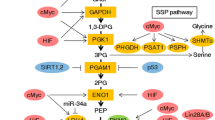Abstract
Bladder cancer (BC) is one of the most common tumors. Metabolic reprogramming is a feature of neoplasia and tumor growth. Understanding the metabolic alterations in bladder cancer may provide new directions for bladder cancer treatment. Sirtuin 1 (SIRT1) is a lysine deacetylase of multiple targets including metabolic regulators. In pancreatic cancer, the loss of SIRT1 is accompanied by a decreased expression of proteins in the glycolysis pathway, such as GLUT1, and cancer cell proliferation. Thus, we hypothesize that SIRT1 may interact with GLUT1 to modulate the proliferation and glycolysis phenotype in bladder cancer. In the present study, the expression of SIRT1 and GLUT1 was upregulated in BC tissues and cell lines and positively correlated in tissue samples. SIRT1 overexpression or GLUT1 overexpression alone was sufficient to promote cell proliferation and glucose uptake in BC cells. EX527, a specific inhibitor of SIRT1, exerted an opposing effect on bladder cancer proliferation and glucose uptake. The effect of EX527 could be partially reversed by GLUT1 overexpression. More importantly, SIRT1 overexpression significantly promoted the transcriptional activity and expression of GLUT1, indicating that SIRT1 increases the transcription activity and expression of GLUT1, therefore, promoting the cell proliferation and glycolysis in BC cells. Our study first reported that SIRT1/GLUT1 axis promotes bladder cancer progression via regulation of glucose uptake.




Similar content being viewed by others
References
Burger M, Catto JW, Dalbagni G, et al. Epidemiology and risk factors of urothelial bladder cancer. Eur Urol. 2013;63:234–41.
Ferlay J, Soerjomataram I, Dikshit R, et al. Cancer incidence and mortality worldwide: sources, methods and major patterns in GLOBOCAN 2012. Int J Cancer. 2015;136:E359-86.
von Rundstedt FC, Rajapakshe K, Ma J, et al. Integrative pathway analysis of metabolic signature in bladder cancer: a linkage to the cancer genome atlas project and prediction of survival. J Urol. 2016;195:1911–9.
Deng SP, Zhu L, Huang DS. Mining the bladder cancer-associated genes by an integrated strategy for the construction and analysis of differential co-expression networks. BMC Genom. 2015;16(Suppl 3):4.
Hanahan D, Weinberg RA. Hallmarks of cancer: the next generation. Cell. 2011;144:646–74.
Vazquez A, Liu J, Zhou Y, Oltvai ZN. Catabolic efficiency of aerobic glycolysis: the Warburg effect revisited. BMC Syst Biol. 2010;4:58.
Frye RA. Characterization of five human cDNAs with homology to the yeast SIR2 gene: Sir2-like proteins (sirtuins) metabolize NAD and may have protein ADP-ribosyltransferase activity. Biochem Biophys Res Commun. 1999;260:273–9.
Kaeberlein M, McVey M, Guarente L. The SIR2/3/4 complex and SIR2 alone promote longevity in Saccharomyces cerevisiae by two different mechanisms. Genes Dev. 1999;13:2570–80.
Preyat N, Leo O. Sirtuin deacylases: a molecular link between metabolism and immunity. J Leukoc Biol. 2013;93:669–80.
Hu Q, Wang G, Peng J, et al. Knockdown of SIRT1 suppresses bladder cancer cell proliferation and migration and induces cell cycle arrest and antioxidant response through FOXO3a-mediated pathways. Biomed Res Int. 2017; 2017:3781904.
Pinho AV, Mawson A, Gill A, et al. Sirtuin 1 stimulates the proliferation and the expression of glycolysis genes in pancreatic neoplastic lesions. Oncotarget. 2016;7:74768–78.
Ancey PB, Contat C, Meylan E. Glucose transporters in cancer—from tumor cells to the tumor microenvironment. FEBS J. 2018.
Yoshizaki T, Milne JC, Imamura T, et al. SIRT1 exerts anti-inflammatory effects and improves insulin sensitivity in adipocytes. Mol Cell Biol. 2009;29:1363–74.
Bai L, Pang WJ, Yang YJ, Yang GS. Modulation of Sirt1 by resveratrol and nicotinamide alters proliferation and differentiation of pig preadipocytes. Mol Cell Biochem. 2008;307:129–40.
Backesjo CM, Li Y, Lindgren U, Haldosen LA. Activation of Sirt1 decreases adipocyte formation during osteoblast differentiation of mesenchymal stem cells. Cells Tissues Organs. 2009;189:93–7.
Lappas M, Mitton A, Lim R, Barker G, Riley C, Permezel M. SIRT1 is a novel regulator of key pathways of human labor. Biol Reprod. 2011;84:167–78.
Lappas M, Andrikopoulos S, Permezel M. Hypoxanthine-xanthine oxidase down-regulates GLUT1 transcription via SIRT1 resulting in decreased glucose uptake in human placenta. J Endocrinol. 2012;213:49–57.
Zhang C, Liu J, Wu R, et al. Tumor suppressor p53 negatively regulates glycolysis stimulated by hypoxia through its target RRAD. Oncotarget. 2014;5:5535–46.
Joo HY, Yun M, Jeong J, et al. SIRT1 deacetylates and stabilizes hypoxia-inducible factor-1alpha (HIF-1alpha) via direct interactions during hypoxia. Biochem Biophys Res Commun. 2015;462:294–300.
Wardell SE, Ilkayeva OR, Wieman HL, et al. Glucose metabolism as a target of histone deacetylase inhibitors. Mol Endocrinol. 2009;23:388–401.
Amann T, Maegdefrau U, Hartmann A, et al. GLUT1 expression is increased in hepatocellular carcinoma and promotes tumorigenesis. Am J Pathol. 2009;174:1544–52.
Oh S, Kim H, Nam K, Shin I. Glut1 promotes cell proliferation, migration and invasion by regulating epidermal growth factor receptor and integrin signaling in triple-negative breast cancer cells. BMB Rep. 2017;50:132–37.
Chan DA, Sutphin PD, Nguyen P, et al. Targeting GLUT1 and the Warburg effect in renal cell carcinoma by chemical synthetic lethality. Sci Transl Med. 2011;3:94ra70.
Li P, Yang X, Cheng Y, et al. MicroRNA-218 increases the sensitivity of bladder cancer to Cisplatin by targeting Glut1. Cell Physiol Biochem Int J Exp Cell Physiol Biochem Pharmacol. 2017;41:921.
North BJ, Verdin E. Sirtuins. Sir2-related NAD-dependent protein deacetylases. Genome Biol. 2004;5:224.
Boren J, Lee WN, Bassilian S, et al. The stable isotope-based dynamic metabolic profile of butyrate-induced HT29 cell differentiation. J Biol Chem. 2003;278:28395–402.
Acknowledgements
This study was supported by Hunan Provincial Natural Science Fund (2017JJ3108).
Author information
Authors and Affiliations
Corresponding author
Ethics declarations
Conflict of interest
None.
Additional information
Publisher’s Note
Springer Nature remains neutral with regard to jurisdictional claims in published maps and institutional affiliations.
Electronic supplementary material
Below is the link to the electronic supplementary material.
Rights and permissions
About this article
Cite this article
Chen, J., Cao, L., Li, Z. et al. SIRT1 promotes GLUT1 expression and bladder cancer progression via regulation of glucose uptake. Human Cell 32, 193–201 (2019). https://doi.org/10.1007/s13577-019-00237-5
Received:
Accepted:
Published:
Issue Date:
DOI: https://doi.org/10.1007/s13577-019-00237-5




